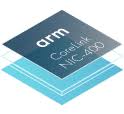On-Chip Communication
On chip communication allows for the transfer of data and instructions between the different functional blocks of a SoC. For instance this could be from the CPU to on ship memory. There are many different protocols and architectures for on chip communications, the choice of which depends on the complexity of the communications needed.
Protocols for on-chip communications are most commonly from Arm's open communication standards, Advanced Microcontroller Bus Architecture (AMBA). There are many protocols included in these standards including APB, AHB, AXI, ACE, and CHI. These protocols are each suited to the specific demands associated with a SoC design depending on complexity, bandwidth and other considerations.
These interfaces are then connected to various subsystems using AMBA compliant buses. This can be a simple bus matrix, or more complex network-on-chip (such as the NIC-400). The protocols can also be used for point-to-point connections where 1 manager is connected directly to 1 subordinate. This can be necessary for very low latency applications.
Some of the considerations and how they are used to plan a bus implementation are described in the project Building system-optimised AMBA interconnect.
Projects Using This Technology













Add new comment
To post a comment on this article, please log in to your account. New users can create an account.